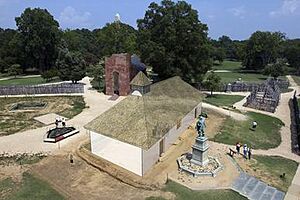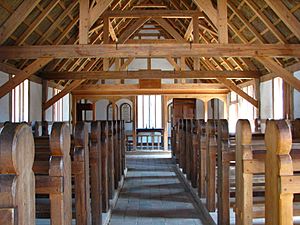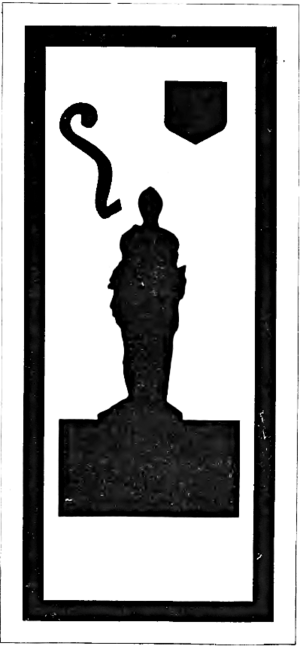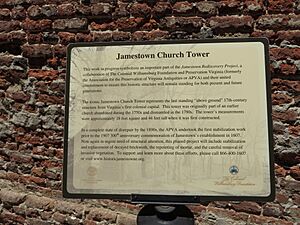Jamestown Church facts for kids
Quick facts for kids Jamestown Memorial Church |
|
|---|---|

Exterior of the 1907 church (with graveyard in left foreground)
|
|
| General information | |
| Architectural style | Artisan Mannerism |
| Location | Historic Jamestown |
| Address | Island Drive, Williamsburg, Virginia |
| Coordinates | 37°12′30.7″N 76°46′42.2″W / 37.208528°N 76.778389°W |
| Design and construction | |
| Architect | Edmund M. Wheelwright, Ralph Adams Cram |
The Jamestown Church, also known as the Jamestown Memorial Church, is a very old church building in Virginia, USA. It stands on the site of Jamestown, which was the first permanent English settlement in the Americas. It was also the first capital of the Colony of Virginia.
Even though the main part of the church was built much later, it includes a ruined brick tower from at least 1637. This tower is the only part of the original Jamestown colony that is still standing. This makes the tower and its church the oldest surviving building made by English settlers in the original Thirteen Colonies. It is one of the oldest buildings in the entire United States. The church also shows how difficult the early days of the Jamestown colony were. It had many different locations and forms over time.
Today, the building is part of the Historic Jamestown site. It is owned by Preservation Virginia, an organization that helps protect old places. The church also sometimes holds services for a group called the Continuing Anglican movement. Archaeologists are currently studying the ruins under and around the church as part of the Jamestown Rediscovery project.
Contents
Why the Church Was Important
When Jamestown was founded, the Church of England was the only Christian religion allowed for English people. Its main beliefs and services were found in the Book of Common Prayer. The Jamestown settlers brought their religion with them to Virginia.
The Church of England was very important to the leaders of the London Company. Before sailing to Virginia, all the men had to promise loyalty to King James. They also had to agree that the Pope had no power over him. In the 1600s, there was no idea of separating church and state. This meant that the church and government worked together closely. Even though colonists were supposed to be Protestant, archaeologists have found Catholic items at Jamestown. This makes some people think that a few early settlers might have secretly been Catholic.
Church services were held 14 times a week in James Fort. Sermons were given on Sundays and on Wednesdays or Thursdays. There were also two prayer services every day, except Sunday, one in the morning and one in the evening. On Sundays, the minister also taught a class about Christian beliefs.
In 1611, Deputy Governor Thomas Dale introduced strict rules called Dale's Code. These rules made church attendance mandatory. People who broke these rules, like speaking badly about God or challenging a preacher, could face serious penalties.
History of the Churches
Experts from Jamestown Rediscovery have studied the site carefully. They believe that six churches were built in two different spots at James Fort. The first two churches were inside the original fort. Churches 3 to 6 were built nearby, on the current site. The oldest part of any structure still standing is the brick tower. It was built sometime in the mid-1600s.
The First Church (1607)
Captain John Smith said that the first church services were held outside. They used an old sail as a roof, tied to three or four trees. Soon after, in 1607, the settlers built the first church inside the fort. Smith described it as "a homely thing like a barn." It was made of wood and covered with earth. This church quickly burned down in a fire on January 7, 1608.
The Second Church (1608)
In 2010, archaeologists found the spot where the second church was built. It was similar to the first one and built in the same place. Since it was made of wood, it needed constant repairs. When Lord De La Warr arrived as governor in 1610, he found the church in bad shape. He had it fixed up and made its inside look better. This is the church where John Rolfe married Pocahontas on April 5, 1614. You can see a recreation of this second church at Jamestown Settlement.
The Third Church (1617–1619)
Between 1617 and 1619, Governor Samuel Argall had the people build a new church. It was 50 feet long and 20 feet wide. This wooden church was built near the old one. It had a foundation of cobblestones, topped with a brick wall. You can still see these foundations under glass in the floor of the current church. This third church was important because the first Representative Legislative Assembly met there on July 30, 1619.
The Fourth Church (1639)
In January 1639, Governor John Harvey reported that people were helping to build a brick church at Jamestown. This church was a bit bigger than the third one. It was built around the third church over the next few years. It was still not finished in November 1647. This church was burned down during Bacon's Rebellion on September 19, 1676.
The Church Tower
Around this time, between 1639 and 1700, a brick church tower was added to an existing church building. It was built in two different stages. Once finished, it was about 46 feet high. It had a wooden roof, a bell tower, and two upper floors. In 1699, the church leaders asked Virginia's government for money to pay for the tower and to fix the church. A visitor in 1702 said the Jamestown church had "a tower and a bell." In the 1890s, the tower was made stronger after Preservation Virginia took care of it.
The Fifth Church (c.1686)
About ten years later, around 1686, a fifth church was in use. It probably used the walls and foundations of the fourth church. This church was used until the 1750s. Then, it was left empty when a new church was built about three miles from Jamestown. The tower remained, but the church building became a ruin by the 1790s. Its bricks were then used to build the graveyard wall.
The Sixth Church (1907)
The current Memorial Church was built in 1907 by the National Society of the Colonial Dames of America. It reused the original tower. This church was built just outside the old cobblestone foundations of the 1617 church and the brick foundations of the 1639 church. It was designed by architects Edmund M. Wheelwright and Ralph Adams Cram from Boston. The design was inspired by St. Luke's Church in nearby Smithfield. That church is similar and dates from 1682. The Jamestown Memorial Church was officially opened on May 11, 1907.
Inside the new building, there are many plaques on the walls. These plaques remember important people from the 1600s. These include Captain John Smith, Pocahontas, Chanco, John Rolfe, Lord de la Warr, Captain Edwin Maria Wingfield, William Claiborne, John Pott, and the first poet in America, George Sandys. A plaque also remembers the start of common law. The furniture in the front part of the church was designed to look like furniture from the 1600s.
Burials at the Church
Inside the Churches
In July 2015, archaeologists from the Jamestown Rediscovery and Smithsonian teams identified the remains of four early colonists. They were found in the chancel area of the second church. These four people are believed to be Rev. Robert Hunt, the first Anglican minister in the Americas; Capt. Gabriel Archer; Sir Ferdinando Wainman, the first English knight buried in America; and Capt. William West. West and Wainman were both nephews of Thomas West, Lord De La Warr, who was the colonial governor when they died.
The "Knight's Tombstone" was originally in the chancel of the third church. It is a black limestone slab with brass designs, including a knight. The person buried there is thought to be either Lord De La Warr or George Yeardley, who became governor after him. It might be Yeardley because his relative, Adam Thorowgood, wrote in his 1680 will that he wanted a marble tombstone with the same design as the Knight's Tomb.
Outside the Churches
By the early 1690s, the graveyard around the brick church covered about 1.5 acres. It stretched through the ruins of James Fort. The earliest burial might have been in the 1640s. The last known burial was in May 1807 during a 200-year anniversary event. There were probably hundreds of burials in the original graveyard. About 50 more were in the area surrounded by the brick wall. This wall was built in the early 1790s using bricks from the old, ruined church.
Another main burial ground is about 250 yards to the west. It is near the large wooden Memorial Cross. There are probably about 300 graves there, likely from the earliest times. None of these graves have tombstones.
Excavation and Restoration
The area around the church has been gradually cleared of trees and plants. This allows archaeologists to study the site more easily. A brick wall and iron gates in front of the church have also been removed. In 2010, archaeologists from Jamestown Rediscovery found the combined remains of Churches 1 and 2.
A big project in 2013 and 2014 helped protect the tower. Workers repaired, relaid, and sometimes replaced bricks. About 5,000 new bricks were made by skilled workers at the Colonial Williamsburg Foundation. These replacement bricks were actually made on-site using local materials and old methods. This project was a team effort between Preservation Virginia and the Colonial Williamsburg Foundation to manage Historic Jamestowne.
In the summer of 2016, students helped at the Jamestown Rediscovery Lab. They uncovered artifacts from around the brick church site. In late November 2016, archaeologists from Jamestown Rediscovery began digging inside the church. This was to prepare for the 400th anniversary of the first meeting of the General Assembly in July 2019.
In Literature
Lydia Sigourney published her poem First Church at Jamestown, Virginia in her book Scenes in my Native Land in 1845.
Images for kids
-
Interior of the reconstructed second Jamestown church at Jamestown Settlement
See also
- Oldest churches in the United States
- Oldest buildings in the United States



















